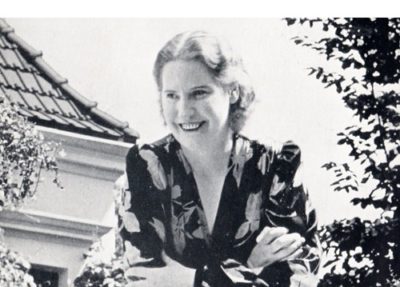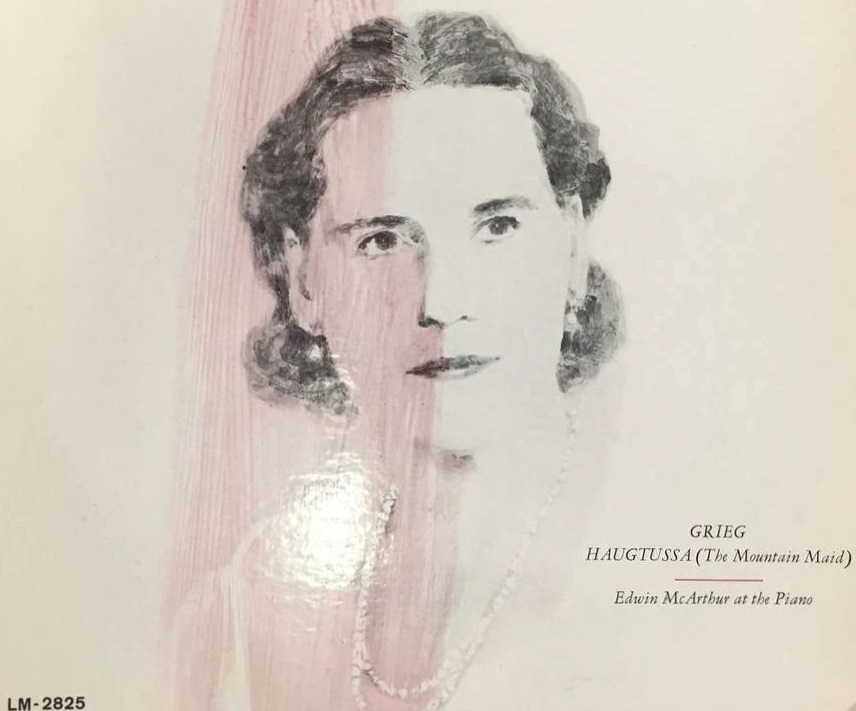Étiquette : Edwin Mc Arthur

Kirsten Flagstad
Wagner Wesendonck Lieder (Der Engel – Stehe still – Im Treibhaus – Schmerzen – Träume)
Filharmonisk Selskaps Orkester (Orchestra of the Philharmonic Society Oslo)
Dirigent: Øivin Fjeldstad (concert Oslo – Nationaltheatret – Dec. 16, 1951)
33t. Acanta BB 23.189
____
Grieg Haugtussa Op.67 (Det Sing – Veslemöy – Blåbær-Li – Møte – Elsk – Killingdans – Vond Dag – Ved Gjætle-Bekken)
Edwin Mc Arthur, piano ( Los Angeles – April 26, 1950)
33t. RCA LM-2825
Ces deux cycles de mélodies sont ceux que Kirsten Flagstad a le plus donné en concert au cours de sa carrière.
Elle a chanté un nombre incalculable de fois les deux derniers Wesendonck Lieder (Schmerzen, Träume) au cours de ses récitals. Mais ce n’est que le 8 juin 1939 qu’elle a donné pour la première fois le cycle complet lors d’un concert à Zurich à la Villa Wesendonck avec l’Orchestre de la Tonhalle sous la direction de Robert Denzler. Elle l’a ensuite chanté quelque 55 fois, que ce soit dans la version avec piano ou avec orchestre, la dernière fois étant à New-York (Carnegie Hall) le 23 mars 1955 avec l’orchestre « Symphony of the Air » dirigé par Edwin Mc Arthur. Elle a enregistré deux fois le cycle, la première avec Gerald Moore au piano (25 & 26 mai 1948) et la seconde avec le WPO dirigé par Hans Knappertsbusch (Sofiensaal 13 & 15 mai 1956). L’enregistrement de la Radio norvégienne, qui bénéficie de l’accompagnement soigné d’ Øivin Fjeldstad est probablement son meilleur avec orchestre. Son état vocal est notamment meilleur que le 9 mai 1952 avec G. Sébastian au Titania Palast de Berlin, où son timbre, peu de temps avant l’enregistrement de Tristan und Isolde avec Furtwängler, apparaît un peu voilé.
Le cycle Haugtussa Op.67 de Grieg est entré à son répertoire le 13 mars 1940 lors d’un récital à New York (Town Hall) avec le pianiste Edwin Mc Arthur. Elle le chantera ensuite environ 35 fois, la dernière étant à Oslo pour la radio le 16 septembre 1954 avec le pianiste Woldemar Alme. Elle l’a enregistré trois fois avec le pianiste Edwin Mc Arthur: le 27 août 1940 à Los Angeles, le 26 avril 1950, également à Los Angeles, trois jours après un récital donné au Philharmonic Auditorium de cette même ville, et enfin à Londres (22-30 novembre 1956).
En 1950, l’enregistrement de cette œuvre qui lui tenait particulièrement à cœur est d’une très grande chaleur expressive, plus que dans ses deux autres prestations pour le disque.
Ce magnifique cycle composé par Grieg en 1895 ne comporte que huit mélodies. Il raconte le premier déboire amoureux d’une jeune montagnarde, Veslemöy. Les références à la nature des poèmes d’Arne Garborg, auxquelles s’ajoute une pointe de mysticisme, et l’invocation au ruisseau qui conclue le cycle font penser à la « Schöne Müllerin » de Schubert. Si ce chef-d’œuvre est pratiquement oublié de nos jours, c’est probablement à cause de la langue des poèmes, difficilement abordable. Pourtant, Flagstad l’a chanté un peu partout aux Etats-Unis y compris dans des villes moyennes situées hors des circuits habituels des concerts. Avec une traduction, le sens des poèmes est aisé à comprendre.

These two Lieder cycles are those of which Kirsten Flagstad gave the most concert performances during her career.
She sang an innumerable number of times the last two Wesendonck Lieder (Schmerzen, Träume) during her recitals. But it is only on June 8, 1939 that she performed the complete cycle for the first time during a concert at the Villa Wesendonck in Zurich with the Tonhalle Orchester conducted by Robert Denzler. She then sang it about 55 times, either in the version with piano or with orchestra, the last time being in New-York (Carnegie Hall) on March 23, 1955 with the « Symphony of the Air Orchestra » conducted by Edwin Mc Arthur. She recorded it twice, the first time with Gerald Moore at the piano (May 25 & 26, 1948) and the second time with the WPO conducted by Hans Knappertsbusch (Sofiensaal May 13 & 15, 1956). The recording made by the Norvegian Radio, with Øivin Fjeldstad’s refined accompaniment is probably her best with an orchestra. Her vocal condition is notably better than on May 9, 1952 with G. Sébastian at the Berlin Titania Palast, where her timbre, not long before the recording of Tristan und Isolde with Furtwängler, sounds slightly veiled.
The cycle Haugtussa Op.67 by Grieg entered her repertoire on March 13, 1940 during a recital in New York (Town Hall) with pianist Edwin Mc Arthur. She then sang it about 35 times, the last one in Oslo as a Radio broadcast on September 16, 1954 with pianist Woldemar Alme. She made three recordings with pianist Edwin Mc Arthur: on August 27, 1940 in Los Angeles, on April 26, 1950, also in Los Angeles, three days after a recital at the Philharmonic Auditorium of that same city, and then in London (November 22-30, 1956).
In 1950, the recording of this work that was especially dear to her, has a very great expressive warmth, more than in her other two studio renditions.
This magnificent cycle composed by Grieg en 1895 is comprised of only eight melodies. It tells the story of the first unhappy love of a mountain maid, Veslemöy. Arne Garborg’s poems make reference to nature, with a touch of mysticism, and the invocation to the brook that ends the cycle makes one think of Schubert’s « Schöne Müllerin ». If this masterpiece is now almost forgotten, it is probably because the language of the poems is not easy of access. However, Flagstad sang it almost everywhere in the United States, included in middle-sized towns far from the usual path of concert tours. With a translation, the meaning of the poems is easy to comprehend.
Les liens de téléchargement sont dans le premier commentaire. The download links are in the first comment.



